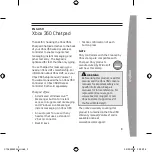
CHAPTER 10: THEORY OF OPERATION
OVERVIEW
L90 LINE CURRENT DIFFERENTIAL SYSTEM – INSTRUCTION MANUAL
10-11
10
In normal operation, frequency tracking at each terminal matches the tracking at all other terminals, because all terminals
measure approximately the same frequency deviation. However, if there is not enough current at a terminal to compute
frequency deviation, then frequency tracking at that terminal is accomplished indirectly via phase locking to other
terminals. A small phase deviation must be present for the tracking to occur.
Also shown in the loop is the clock itself, because it behaves like an integrator. The clock is implemented in hardware and
software with a crystal oscillator and a counter.
Figure 10-3: Loop filter block diagram
There are four gains in the filter that must be selected once and for all as part of the design of the system. The gains are
determined by the time step of the integrators, and the required time constants of the system as follows:
Eq. 10-27
where
T
repeat
= the time between execution of the filter algorithm
T
phase
= time constant for the primary phase locked loop
T
frequency
= time constant for the frequency locked loop
10.1.13 Matching phaselets
An algorithm is needed to match phaselets, detect lost messages, and detect communications channel failure. Channel
failure is defined by a sequence of lost messages, where the length of the sequence is a design parameter. In any case, the
sequence is no longer than the maximum sequence number (four cycles) in order to be able to match up messages when
the channel is assumed to be operating normally.
A channel failure can be detected by a watchdog software timer that times the interval between consecutive incoming
messages. If the interval exceeds a maximum limit, channel failure is declared and the channel recovery process is
initiated.
While the channel is assumed to be operating normally, it is still possible for an occasional message to be lost, in which
case fault protection is suspended for the time period that depends on that message, and is resumed on the next
occasional message. A lost message is detected simply by looking at the sequence numbers of incoming messages. A lost
message shows up as a gap in the sequence.
















































